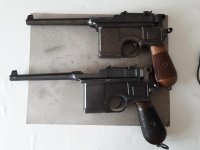Then, if so, what else could we banter about here ? Sal Raimondi
Well, given the rules of this hive, I'll at least start off obeying them---and talk about a single shot---one that perhaps should never have been. (That won't take very long, so I'll finish with one of those hand ejector things------that doesn't belong here.)
First things first, I give you the Straight Line Single Shot Pistol----ostensibly the worlds' greatest (or so I'm told that's what the questionnaire asked for-----------If you could have the world's greatest single shot pistol, what would it be?). I'm told the results of this survey of the country's finest shooters were boiled down, double distilled, and out came the Straight Line (arguably the, or one of very few commercial disasters in the history of the company----so bad they wouldn't even talk about it for years afterwards----if a, could'a, would'a, should'a).
So what was the problem? The problem was they asked for input on a single shot. They asked for it at a time when the NRA's slow/timed/rapid course of fire was gaining favor, and the shooters wanted to try it----and doing timed and rapid fire with a single shot just isn't the name of the game----rather akin to the world's greatest dog food----the one with just one problem: The dogs wouldn't eat it!!
Speaking of dogs, now I give you the very first K-22 Outdoorsman---what could have been---very likely should have been: The time is 1910-1912---thereabouts. The place is Springfield, Massachusetts. A group of Army officers wanted some heavyweight .22 caliber target revolvers. I imagine the S&W folks sang the praises of the "Heavy Frame Target" revolver long and loud, but the Army folks must have replied along the lines of "No man, HEAVY!!"---and 20 .38 caliber M&P Targets were transformed---into heavyweight .22 caliber target revolvers. Mr. Roper, the fellow that told this story the first time around, said they were things of beauty.
The Army guys said they didn't work worth a damn, and returned them---every one. And S&W destroyed them---all but one. That one found its way to Roper (by way of his then new boss-----about ten years later). The Boss Man suggested Roper might like to fiddle around with it some---and see if he could figure out why it didn't work. Then, of course, the Boss Man told him they'd already decided it was because the throats were too long. Undaunted, Roper fiddled with it some. He found out the throats may very well have contributed to the difficulties, but they weren't the answer. The answer came one day when Walter noticed his cleaning rod was turning too fast. And that's because the barrel was rifled with one turn in ten inches---instead of one turn in fifteen or sixteen inches.
I reckon maybe someone was asleep at the switch---again.
Ralph Tremaine

